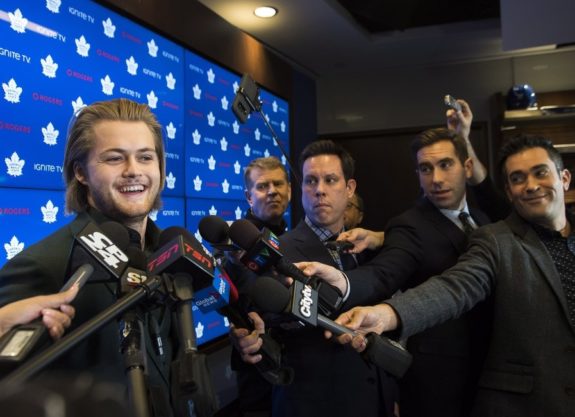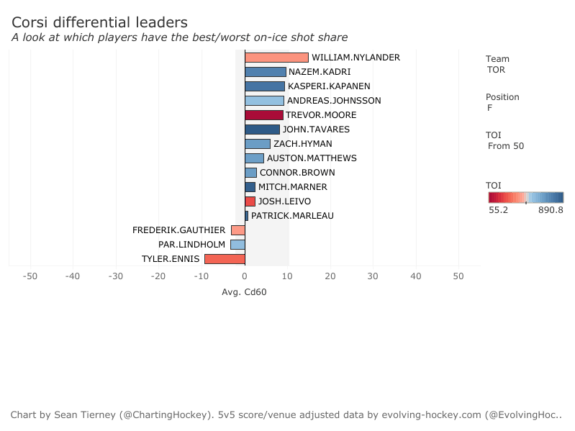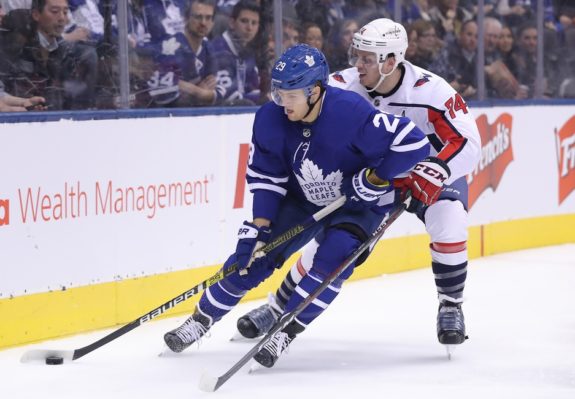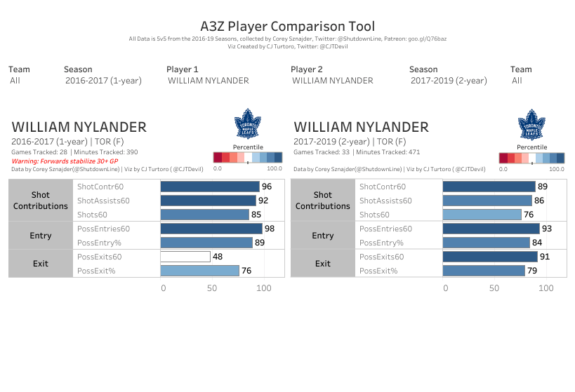![]()
I don’t think it would be inaccurate to say Toronto Maple Leafs forward William Nylander enraged some fans when he held out for more money at the start of the 2018-19 season. When he finally inked a six-year contract with an average annual value of $6.96 million, it came with certain expectations: you better produce (or else!).
The 22-year-old winger had certainly done just that in his first two full National Hockey League seasons, posting back-to-back 61-point seasons in 2016-17 and 2017-18. But when he finally returned to the ice in early December, things didn’t start out so well.
Not that he speaks for all fans, but TSN 1050 OverDrive co-host Bryan Hayes said on Dec. 10 that Nylander’s grace period should be over after going pointless in his first two games. This enraged TSN hockey analyst and former NHLer Ray Ferraro who said Nylander should get at least two weeks. Well, Nylander didn’t score in his first 11 games, posting just two assists in that span. From Dec. 6-Jan. 18, a span of 19 games, the Swede had recorded a measly three points. Three! That’s when a larger chunk of Leafs Nation really wanted Nylander’s head (or so it seemed).

Some of those fans pointed out that the Maple Leafs had gone 20-8 without him and then went 9-8-2 during his 19-game slump. They (incorrectly) concluded: who needs him? Well, since Jan. 20, Nylander has posted nine points in his last 12 games, and more importantly, he looks like his old self.
Related – Travis Dermott: Maple Leafs’ Star in the Making
With a total of just 12 points in 31 games thus far, you may feel the need to roast me in the comments below for suggesting that Nylander is performing as expected. Before you do that, please hear me out.
Maple Leafs Creating Offence With Nylander on the Ice
Sometimes, points don’t tell the whole story. Sometimes, you need to actually watch the games to see who’s feeling it and who isn’t. Sometimes, you need to dig a little deeper to see some positive signs.
Twelve points in 31 games sounds bad. It is bad. But to suggest Nylander has only started playing well the last few weeks would be incorrect. Yes, he is absolutely playing his best hockey as of late, but that doesn’t mean he was poor throughout his entire slump.

The chart above shows that across the entire season, Nylander has the best differential between shot attempts for and shot attempts against among Maple Leafs forwards, at 14.93. That’s top-20 in the NHL for forwards with at least 350 minutes played at five-on-five. Let’s take a closer look at the Maple Leafs offensive metrics with Nylander on the ice from his first 19 games (one goal, two assists) compared to his most recent 12 games (two goals, seven assists), with the league rank in brackets.
| William Nylander’s 5v5 Offence | CF/60 | CF% | SCF/60 | SCF% | GF/60 | GF% |
| First 19 GP (Dec. 6-Jan.19) | 70.53 (9th) | 54.21% (45th) | 33.89 (11th) | 55.74% (42nd) | 1.74 (203rd) | 36.84 (211th) |
| Last 12 GP (Jan. 20-Feb 19) | 73.94 (7th) | 57.46% (8th) | 38.81 (3rd) | 58.64% (7th) | 4.09 (T-15th) | 90.91 (1st) |
First, we see that there is only a slight difference in shot attempts per-60 minutes, from 70.53 Corsi for per-60 (CF/60) to 73.94 CF/60.
If we look at scoring chances instead of shot attempts, we can see that Nylander’s line has done a much better job of getting into dangerous areas in the offensive zone in 2019. In Nylander’s first 19 games, the Maple Leafs generated 33.89 scoring chances for per-60 minutes (SCF/60) with him on the ice at five-on-five.
In the 12 games since, they have recorded 38.81 SCF/60 with Nylander on the ice at five-on-five, the third highest total for any forward in the NHL (minimum 140 minutes played). With Nylander averaging 12:30 of five-on-five ice-time per-game (TOI/GP), that’s the difference of roughly one scoring chance per contest when he’s on the ice.

When you get to the goal totals, it becomes clear why Nylander tallied just three points in his first 19 games. He and his linemates were not finishing. With Nylander on the ice, the Maple Leafs scored just 1.74 goals per-60 minutes in his first 19 games. In his last 12 games, the team has scored 4.09. He has also been on the ice for 10 goals for and just one against at five-on-five in his last 12 games, compared to seven goals for and 12 against in his first 19 games.
Babcock’s Reluctance to Reunite Nylander & Matthews
I understand why Maple Leafs head coach Mike Babcock did not place Nylander on Auston Matthews’ wing right when he returned from his standoff in contract negotiations. Nylander certainly needed time to get acclimatized before earning top minutes.
But here we are, with Nylander now on a roll, and guess what: he’s still skating on the third line. From 2016-18 — when Nylander recorded back-to-back 61-point seasons — Nylander spent most of his time ripping it up with Matthews. This season, his most common centre is Nazem Kadri.
| Nylander’s Centre(s) | 5v5 TOI With | Nylander 5v5 Total TOI | % of Total 5v5 TOI With |
| Nazem Kadri 2018-19 | 238:34 | 387:37 | 61.6% |
| Auston Matthews 2018-19 | 100:22 | 387:37 | 25.9% |
| Nazem Kadri 2016-18 | 495:58 | 2185:41 | 22.7% |
| Auston Matthews 2016-18 | 1342:55 | 2185:41 | 61.4% |
As you can see, the script has pretty much flipped entirely. Perhaps it’s because in the 100 minutes with Nylander and Matthews together this season, the Maple Leafs have only controlled 46.15 per cent of shot attempts, compared to Nylander controlling over 59 per cent without Matthews. However, 90 of those 100 minutes spent together were before Nylander found his mojo.
Related: Matthews’ First 100 Goals — What the Stats Say
What’s even stranger than Nylander’s linemates is his average ice-time, which has actually gone down (albeit only slightly) since he started piling up points. Despite improving from 0.75 points per-60 minutes (P/60) in the first 19 games to 3.27 (P/60) in his last 12, Nylander has actually seen a slight decrease in average ice-time from 12:40 to 12:14 TOI/GP at five-on-five.
https://twitter.com/arvi/status/1098068920550846465
I would say it’s time to reunite Nylander and Matthews, however, Kadri suffered a concussion on Tuesday, so it’s likely Nylander will be moved to centre for the next little while. That is absolutely the right thing to do with him playing so well.
Nylander a Good Bet to Excel at Centre
Kadri took a hard open-ice hit from St. Louis Blues defenceman Vince Dunn in the first period of Tuesday’s game and did not return for the second period. Nylander moved to the middle to centre the third line between Andreas Johnsson and Connor Brown.
Nylander: "I'm feeling pretty good, skating well & chances are there & they're coming, that's all I can say."
Babcock on William at centre: "First couple of shifts maybe not as good defensively. In the third, he was good defensively & offensively & was a factor in the game."
— Mark Masters (@markhmasters) February 20, 2019
One reason I think Nylander will work well at centre, at least for the short-term (if Babcock does indeed put him there), is because one of his biggest strengths are zone exits and entries. When he’s playing centre, he’ll have the puck on his stick more often in the defensive zone and because he’s such a skilled puck handler, he can often carry it through the neutral zone and into the offensive zone with speed. On Tuesday night, Nylander had six controlled entries and four controlled exits, which were both second on the team, according to The Athletic’s Dom Luszczyszyn (from ‘Leafs Report Cards: Game 59 at St. Louis’ – The AthleticNHL – 2/20/19).
Since his first full rookie season (2016-17), look at how much Nylander has improved in terms of the number of zone exits with possession.

You can see Nylander’s success rate at exiting the zone with possession has barely changed, going from the 76th percentile in his rookie season to the 79th the last two seasons, but the number of possession exits per-60 minutes has nearly doubled, from the 48th percentile to the 91st. Even with him carrying the puck out of the d-zone nearly twice as often, he is still entering the offensive zone with possession at an extremely high rate, in the 93rd percentile the past two seasons.

There are a number of factors that lead me to believe Nylander’s hot streak will continue into March and, hopefully, April as well. First, he and his linemates were getting chances and controlling possession in late December and January, even before his point totals began to rise. Second, Babcock has little choice but to increase his ice-time with Kadri injured. And third, Nylander’s confidence level is currently through the roof. While Nylander hasn’t earned his salary yet for this season, let’s reserve judgment until at least the regular season comes to an end. Or, better yet, until we see what he’ll do in the postseason. It should be fun to watch.
*Stats and research courtesy of Natural Stat Trick